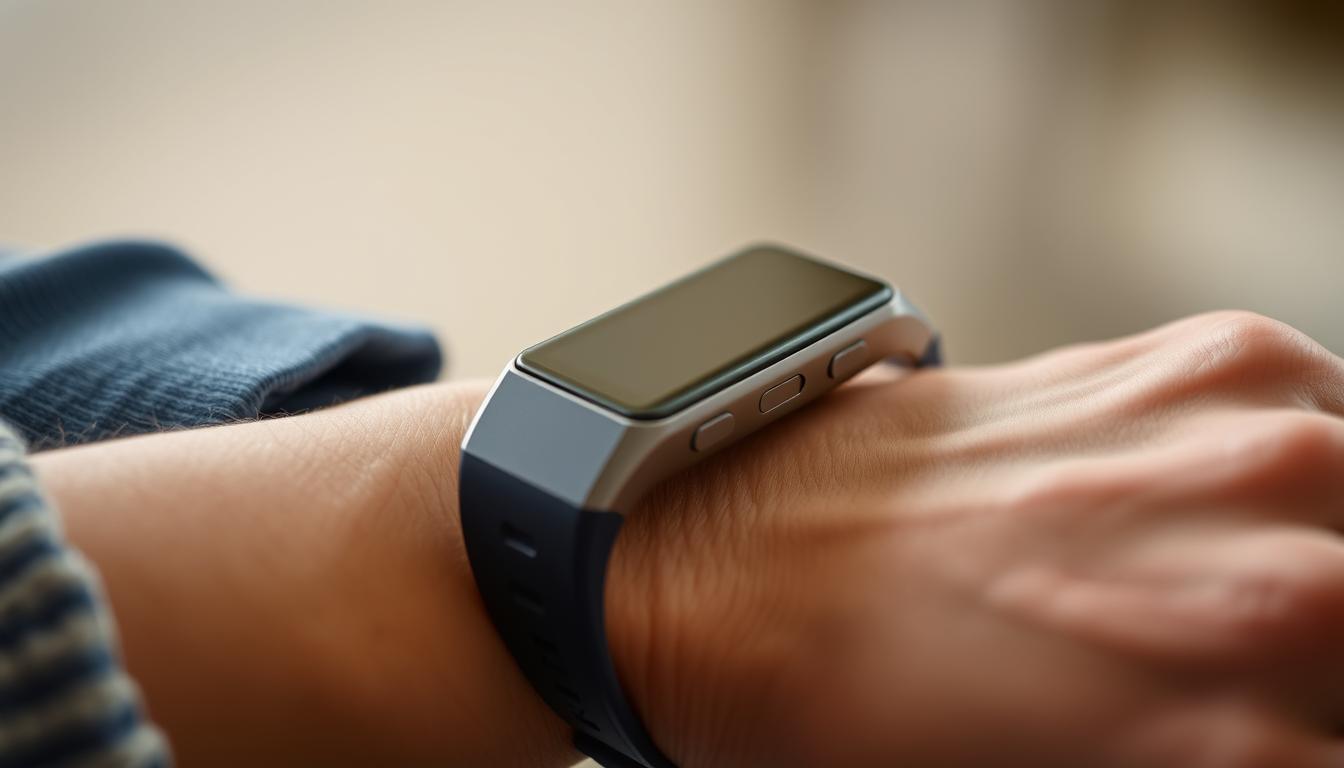The rapid advancement of technology has led to the development of innovative wearable devices that cater to the unique needs of individuals with disabilities. These wearables are designed to promote accessibility and inclusivity in the realm of fitness.

By leveraging wearable technology, individuals with disabilities can now monitor their health and engage in physical activity with greater ease and independence. The importance of inclusive tech cannot be overstated, as it empowers people to take control of their well-being.
Key Takeaways
- Wearable technology is revolutionizing fitness for people with disabilities.
- Inclusive design is crucial for accessibility in fitness technology.
- Adaptive wearable tech is transforming lives by providing greater independence.
- Various fitness devices are available for people with different abilities and needs.
- Technology is making fitness more accessible and inclusive for everyone.
Understanding Wearable Technology for Accessibility
Wearable technology, once a novelty, has become a vital tool for enhancing accessibility and independence for individuals with disabilities. The evolution of wearable devices has led to a complex ecosystem that offers a wide range of functionalities beyond basic fitness tracking.

The Evolution of Adaptive Wearable Tech
The evolution of wearable technology has been remarkable, transforming from simple fitness trackers to sophisticated adaptive devices designed for accessibility needs. Early wearable tech primarily focused on fitness for the general population but has now evolved to address the unique challenges faced by people with disabilities. Advances in sensors, connectivity, and artificial intelligence have been key drivers in this transformation.
How Wearable Devices Enhance Independence
Modern wearable devices significantly enhance independence by providing real-time assistance, monitoring health metrics, and facilitating communication for people with various disabilities. These technologies help users navigate their environments, manage health conditions, and participate more fully in daily activities. By leveraging wearable technology, individuals with disabilities can lead more autonomous lives.
Benefits of Fitness Gadgets for Disabilities
For people with disabilities, fitness gadgets offer a multitude of benefits that enhance their overall quality of life. These devices are designed to provide personalized support, monitoring, and motivation, helping individuals manage their health more effectively.
Health Monitoring and Personal Safety
Wearable technology enables individuals with disabilities to monitor their health conditions closely. These devices can track vital signs, provide medication reminders, and alert users to potential health risks, thereby enhancing personal safety.
Improving Physical Activity and Rehabilitation
Fitness gadgets can be adapted to various physical limitations, offering customized exercise tracking and rehabilitation support. This tailored approach helps individuals with disabilities to engage in physical activity that is appropriate for their abilities, improving overall rehabilitation outcomes.
Enhancing Social Connection and Motivation
Connected fitness devices foster social connection among users with disabilities, creating networks of support and friendly competition. The integration of gamification elements and achievement tracking in these gadgets significantly boosts motivation and adherence to physical activity routines.
Smartwatches and Fitness Trackers for Different Abilities
For individuals with disabilities, smartwatches and fitness trackers can be invaluable tools, providing a range of accessibility features that enhance their fitness routines and overall quality of life.

Apple Watch Accessibility Features
The Apple Watch offers a comprehensive set of accessibility features, making it an excellent choice for individuals with disabilities. The VoiceOver screen reader helps users with vision impairments navigate the system. Additionally, the Apple Watch includes zoom features and an oversized watch face for those with limited vision. Apple's Taptic Engine uses haptic feedback to alert users about notifications, messages, or reminders with a "tap" on the wrist.
Android Wear and Samsung Options
Android Wear devices, including those from Samsung, offer robust accessibility features. TalkBack, a readout feature, assists users with visual impairments by providing audible descriptions of the screen content. Furthermore, Google Assistant integration enables users to perform various tasks with voice commands, enhancing the overall accessibility of these devices. Samsung Gear devices also offer a smoother screen reader function, grayscale mode, and an inverted color option for higher visibility.
Specialized Fitness Trackers
There are also specialized fitness trackers designed specifically for people with disabilities. These devices often feature simplified interfaces, enhanced durability, and specialized sensors for particular health conditions. They cater to the unique needs of individuals with various disabilities, providing a more tailored approach to fitness tracking.
Smart Glasses and Visual Assistance Devices
Visual assistance devices, including smart glasses, are playing a crucial role in improving the lives of people with visual impairments. These innovative technologies are designed to enhance independence and facilitate interaction with the environment.

Google Glass and OrCam Technologies
Google Glass and OrCam are two significant players in the field of visual assistance. OrCam helps people with vision-related disabilities identify objects they cannot see and read texts through audio feedback. The OrCam uses a tiny camera and an earpiece, which can be attached to eyeglasses, to read and convey information audibly.
Navigation and Environmental Recognition Features
These visual assistance devices incorporate advanced features like environmental recognition, obstacle detection, and spatial awareness to enhance safety during physical activities. The navigation capabilities of smart glasses can guide users through unfamiliar environments, provide real-time feedback during exercise, and enhance independence.
Adaptive Wearable Tech for Mobility Impairments

Advancements in adaptive wearable tech are enhancing the lives of individuals with mobility impairments. Wearable devices are being developed to provide physical aid and convenience, significantly impacting daily life.
Exoskeletons and Smart Clothing
Exoskeletons and smart clothing embedded with sensors are revolutionizing the way individuals with mobility impairments engage in physical activities. These wearable technologies facilitate locomotion, providing newfound freedom and mobility. Exoskeleton technology ranges from full-body systems to targeted joint assistance devices, enabling new forms of exercise and movement.
Smart clothing with integrated sensors can monitor movement patterns, provide feedback for proper form, and assist with rehabilitation exercises. This technology is particularly beneficial for individuals undergoing physical therapy.
Sensor-Based Movement Assistance
Sensor-based movement assistance technologies detect user intentions and provide appropriate support, making physical activities more accessible. These technologies can be integrated into fitness routines, enabling people with mobility impairments to participate in a wider range of physical activities. The potential for future developments in this field is vast, promising further transformation in fitness opportunities for people with mobility limitations.
The use of sensors in wearable technology is crucial for providing real-time feedback and assistance. This not only enhances the user's ability to perform physical activities but also reduces the risk of injury.
Choosing the Right Fitness Gadget for Your Needs
Understanding your individual needs is the first step towards selecting a fitness gadget that enhances your fitness goals. With numerous options available, it's essential to consider several factors to make an informed decision.
Assessing Individual Requirements
Assessing your individual requirements is crucial when choosing a fitness gadget. This includes understanding the specific nature of your disability, your fitness goals, technical comfort level, and daily routines. By considering these factors, you can narrow down your options to devices that are tailored to your needs.
Compatibility with Other Assistive Technologies
Another critical aspect is ensuring that the chosen fitness gadget is compatible with other assistive technologies you use. This may include hearing aids, wheelchairs, or screen readers. Ensuring compatibility enhances the overall user experience and ensures seamless integration into your daily life.

Privacy and Data Security Considerations
"Robust data security is essential to protect users' privacy and personal information."
When purchasing a fitness gadget, it's vital to buy from areputable manufacturerthat prioritizesdata securityand does not misuse customer data. This consideration is particularly important for users who share sensitive health information through these devices.
By carefully assessing your needs, ensuring compatibility, and considering privacy and data security, you can choose a fitness gadget that not only meets your requirements but also enhances your overall fitness journey.
Conclusion: The Future of Inclusive Fitness Technology
The integration of wearable technology and accessibility is creating a more inclusive fitness landscape. As technology continues to advance, it is likely to play a crucial role in enhancing the lives of individuals with disabilities.
With innovation driving the industry forward, we can expect wearables to become even more sophisticated, offering hyper-personalized solutions that cater to individual needs and preferences. The future of fitness technology looks promising, with potential breakthroughs in artificial intelligence and machine learning that will further enhance accessibility.
By fostering collaboration between technology developers, healthcare professionals, and disability advocates, we can ensure that inclusive tech continues to evolve, making fitness more accessible to everyone.
